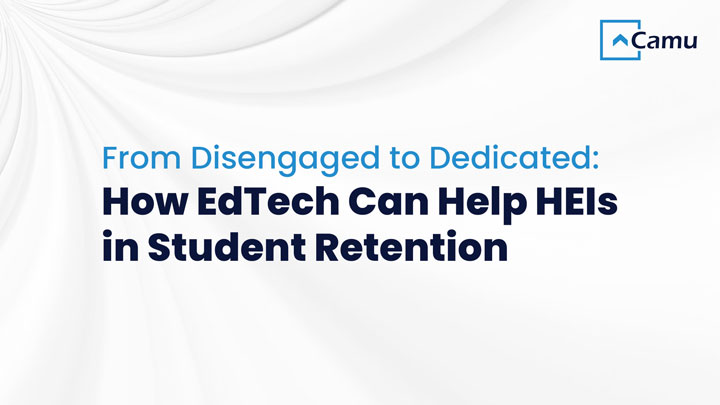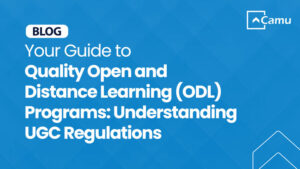
From Disengaged to Dedicated: How EdTech Can Help HEIs in Student Retention
The Challenge of Student Attrition
Higher education institutions (HEIs) often welcome a wave of enthusiastic new students eager to embark on their academic journeys. Fueled by a sense of accomplishment and a desire for independence, these freshmen arrive with high expectations. However, this initial excitement can quickly diminish, leading us to a concerning trend: student attrition.
This isn’t an issue isolated to one region but is rather pervasive. Studies show that in the United States, for example, more than a quarter of first-year undergraduate students don’t return for their second year. Similarly, the Philippines grapples with university attrition rates estimated to be about 30%.
Traditionally, the onus of completing a course fell solely on the student. However, the focus is shifting, with a growing expectation for HEIs to take a more proactive role in retaining students and supporting their success.
The Root of the Problem: Disengagement
Financial constraints, health concerns, and family issues can undoubtedly contribute to student attrition. However, research indicates that a substantial portion of dropouts stem from a lack of engagement with their academic pursuits. Several factors can lead to this disengagement:
- Limited Real-World Connection: When students fail to see the practical application of their studies, their interest can wane.
- Restricted Learner Autonomy: Feeling like passive consumers of knowledge, rather than proactive participants in the learning process, can disenfranchise students.
- Monotonous Teaching Methods: A reliance on a single teaching style fails to cater to diverse learning styles and can quickly lead to student disillusionment.
- Inadequate Feedback: The absence of regular, constructive feedback leaves students without a clear understanding of their progress, hindering motivation.
- Social Disconnection: A lack of connection with peers, especially for students from varied backgrounds, can foster feelings of isolation and hinder academic integration.
- Limited Faculty Interaction: Large class sizes or high student-to-faculty ratios often restrict opportunities for personalized attention, leading to student disaffection.
- Inefficient Administrative Systems: Cumbersome administrative processes, a lack of transparency in decision-making, and limited access to information can cultivate student frustration and negativity towards the institution.
By addressing these factors, HEIs can foster a more engaging learning environment, ultimately contributing to improved student retention rates.
The EdTech Solution: Strategies for Enhanced Retention
EdTech platforms, such as the Unified Student Information System (SIS) and Learning Management System (LMS) from Camu, offer a powerful toolkit for HEIs to combat student disengagement and cultivate a thriving learning environment that fosters retention. Here’s how:
- Personalized Learning: EdTech platforms can individualize learning experiences to cater to the specific needs of each student. By analyzing student performance and interests, content can be dynamically adjusted to keep them engaged. This personalized approach promotes deeper comprehension and remembering of concepts.
- Interactive Engagement: EdTech platforms are not passive learning environments. Interactive components like quizzes, virtual modelling, and discussion forums keep students actively involved, boosting motivation and absorption.
- Meaningful Feedback and Progress Tracking: Regular, personalized feedback through EdTech tools allows students to monitor their progress and identify areas for improvement. This grants them the autonomy to take control of their learning and helps them stay on track.
- Gamification for Enhanced Engagement: Gamifying the learning experience by incorporating points, badges, and leaderboards can make studying more fun and engaging. This playful approach not only fosters healthy competition but also motivates students to persist, leading to improved retention rates.
- Collaborative Learning through Technology: EdTech platforms can facilitate collaboration among students through online forums, group projects, and real-time communication tools. This collaborative learning environment promotes deeper understanding, improves communication skills, and ultimately strengthens student engagement and retention.
- Data-Driven Insights for Improvement: EdTech platforms gather insightful data on learner behaviours and study patterns. HEIs can analyze this data to identify areas where students struggle and tailor their interventions accordingly. This approach driven by data facilitates continual refinement, leading to a more effective learning environment.
- Prompting Action with Notifications: In-app or push notifications can be used strategically to remind students of upcoming deadlines, encourage participation in activities, or offer personalized support. These timely prompts can help keep them engaged and on track, contributing to improved retention.
- Streamlined Onboarding For A Smooth Start: A user-friendly onboarding process is crucial for student success. EdTech platforms with clear tutorials and easy-to-navigate interfaces ensure a smooth learning experience from the outset. When students can quickly grasp the platform’s value and functionality, they’re more likely to remain engaged.
- Future-proofing Skills with EdTech: The ever-evolving job market demands continuous learning. EdTech platforms can provide seamless access to upskilling and cross-skilling courses, empowering students to stay relevant and competitive. This focus on future-proofing skills boosts student satisfaction and enhances retention rates.
- Holistic Support Beyond Academics: Retention extends beyond academics. EdTech can facilitate access to non-academic support services, such as virtual mentoring, online mental health resources, and financial aid applications. By addressing students’ well-being comprehensively, HEIs can create a more supportive environment and promote higher retention.
Foreseeing the Future: Fewer Dropouts, More Success
By embracing EdTech solutions, HEIs can empower students, nurture a more engaging learning environment, and ultimately combat student attrition. Personalized learning experiences, interactive elements, data-driven insights, and readily available support services all contribute to a more enriching and rewarding educational journey. As EdTech continues to evolve, its potential to transform student retention and empower future generations of learners is limitless.







